Last weekend I saw the Ancient Lives, New Discoveries exhibition at the British Museum. The exhibition is a display of 8 ancient Egyptian mummies dating between 3500BC and 700AD. The BM is using new hospital CT scans to learn about what is under the mummies’ wrappings to learn about the mummies without damaging and destroying them.
The first, and oldest, mummy was naturally preserved in the dry desert sand. Through the scans, BM scientists are able to tell his age through marks on the skeleton and even what it is likely he ate for his last meal. The Museum had computers throughout the galleries which helped visitors to see and understand what the scans showed.
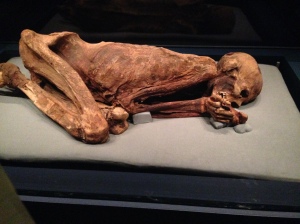
The second mummy is of a man, but was in a woman’s coffin. Many of the mummies in this exhibition showed dental abscesses which appeared to be common in the wealthy elite that were mummified and would have been extremely painful. Almost all the mummies showed these through the CT scans.
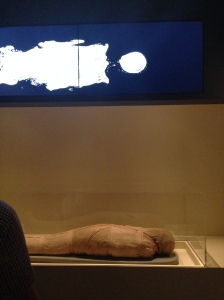
An interesting note from the Museum stated that for many of the mummies found, it is difficult if not impossible to determine the cause of death as we are only able to study the bones which often to not show signs of illnesses or disease. Dental abscesses and artery clots are two of the only visible signs of health on the mummies.
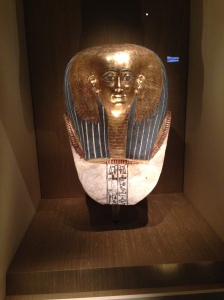
Through theseCT scans, experts are able to identify amulets within the mummies’ wrapping and in some cases they can even tell what the amulets are made of and what they represent. The scans are able to recreate 3D images of the amulets and, amazingly, can even print off 3D copies of the objects inside! From one mummy, a high ranking priests daughter, the BM was able to recreate several of the amulets without damaging the mummy itself. The amulets were of birds and other representations of their gods; Egyptians believed that spells and chants from the Book of the Dead would activate the amulets’ protection on the body. The Egyptians mummified their dead because they believed the preservation of the body was necessary for the preservation and security of the soul.
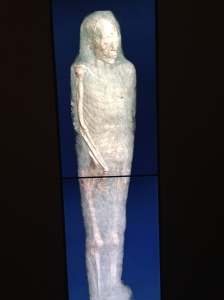
Throughout the exhibition there were other ancient Egyptian artifacts including a copy of the Book of the Dead, funerary objects, and embalming tools.
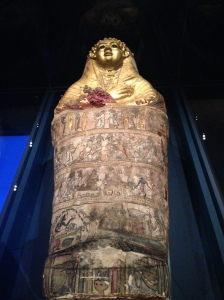
While it was only the wealthy elite that could afford to be mummified, the exhibition showed a variety of class levels, including a high-priestess, a temple doorkeeper, and young temple singer. Not all of the mummies were embalmed perfectly and the temple doorkeeper’s embalmers had done a botched job – not stabilizing his head had resulted in having to insert metal rods in his neck and adding several inches on to his coffin as he was too tall. The scans were able to demonstrate all of this and make it visible and understandable to visitors.
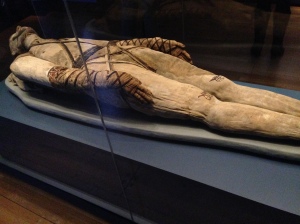
Mummification continued in Egypt through Roman times, but eventually was stopped by the rise of Christianity. The most recent mummy was a naturally preserved Christian woman living in the early 8th century. She had a tattoo on her leg symbolizing St Michael which helped experts identify her as a Christian.
The end of the exhibition offered visitors the chance to look into the faces of the priestess, the temple doorkeeper and Christian woman. Through the modern scans and ancient preservation techniques, the faces of these individuals are nearly intact. It is strange to be face to face with someone that lived so many years ago. I admire the BM for not having been rash 100 years ago and unwrapping these mummies for instant gratification while creating permanent damage to the mummies. Because of their foresight, we are now able to understand the mummies and continuously learn from them.
– V
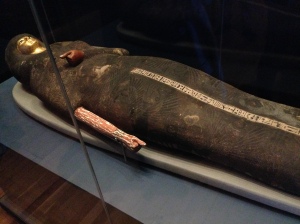
oh wow !!!!!
Hi Tori
Sounds like a very interesting exhibition.
Linda x
Sent from my iPad
>